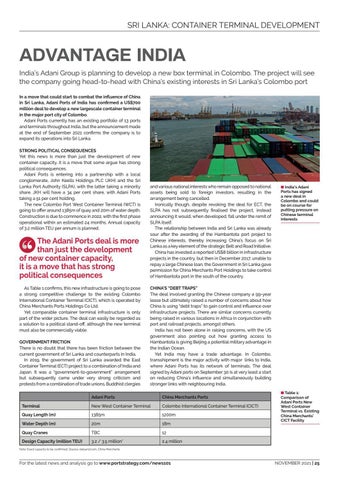SRI LANKA: CONTAINER TERMINAL DEVELOPMENT
ADVANTAGE INDIA India’s Adani Group is planning to develop a new box terminal in Colombo. The project will see the company going head-to-head with China’s existing interests in Sri Lanka’s Colombo port In a move that could start to combat the influence of China in Sri Lanka, Adani Ports of India has confirmed a US$700 million deal to develop a new largescale container terminal in the major port city of Colombo. Adani Ports currently has an existing portfolio of 13 ports and terminals throughout India, but the announcement made at the end of September 2021 confirms the company is to expand its operations into Sri Lanka. STRONG POLITICAL CONSEQUENCES Yet this news is more than just the development of new container capacity, it is a move that some argue has strong political consequences. Adani Ports is entering into a partnership with a local conglomerate, John Keells Holdings PLC (JKH) and the Sri Lanka Port Authority (SLPA), with the latter taking a minority share. JKH will have a 34 per cent share, with Adani Ports taking a 51 per cent holding. The new Colombo Port West Container Terminal (WCT) is going to offer around 1385m of quay and 20m of water depth. Construction is due to commence in 2022, with the first phase operational within an estimated 24 months. Annual capacity of 3.2 million TEU per annum is planned.
‘‘
The Adani Ports deal is more than just the development of new container capacity, it is a move that has strong political consequences As Table 1 confirms, this new infrastructure is going to pose a strong competitive challenge to the existing Colombo International Container Terminal (CICT), which is operated by China Merchants Ports Holdings Co Ltd. Yet comparable container terminal infrastructure is only part of the wider picture. The deal can easily be regarded as a solution to a political stand-off, although the new terminal must also be commercially viable. GOVERNMENT FRICTION There is no doubt that there has been friction between the current government of Sri Lanka and counterparts in India. In 2019, the government of Sri Lanka awarded the East Container Terminal (ECT) project to a combination of India and Japan. It was a “government-to-government” arrangement but subsequently came under very strong criticism and protests from a combination of trade unions, Buddhist clergies
and various national interests who remain opposed to national assets being sold to foreign investors, resulting in the arrangement being cancelled. Ironically though, despite revoking the deal for ECT, the SLPA has not subsequently finalised the project, instead announcing it would, when developed, fall under the remit of SLPA itself. The relationship between India and Sri Lanka was already sour after the awarding of the Hambantota port project to Chinese interests, thereby increasing China’s focus on Sri Lanka as a key element of the strategic Belt and Road Initiative. China has invested a reported US$8 billion in infrastructure projects in the country, but then in December 2017, unable to repay a large Chinese loan, the Government in Sri Lanka gave permission for China Merchants Port Holdings to take control of Hambantota port in the south of the country.
8 India’s Adani Ports has signed a new deal in Colombo and could be on course for putting pressure on Chinese terminal interests
CHINA’S “DEBT TRAPS” The deal involved granting the Chinese company a 99-year lease but ultimately raised a number of concerns about how China is using “debt traps” to gain control and influence over infrastructure projects. There are similar concerns currently being raised in various locations in Africa in conjunction with port and railroad projects, amongst others. India has not been alone in raising concerns, with the US government also pointing out how granting access to Hambantota is giving Beijing a potential military advantage in the Indian Ocean. Yet India may have a trade advantage. In Colombo, transshipment is the major activity with major links to India, where Adani Ports has its network of terminals. The deal signed by Adani ports on September 30 is at very least a start on reducing China’s influence and simultaneously building stronger links with neighbouring India.
Adani Ports
China Merchants Ports
Terminal
New West Container Terminal
Colombo International Container Terminal (CICT)
Quay Length (m)
1385m
1200m
Water Depth (m)
20m
18m
Quay Cranes
TBC
12
Design Capacity (million TEU)
3.2 / 3.5 million*
2.4 million
8 Table 1: Comparison of Adani Ports New West Container Terminal vs. Existing China Merchants’ CICT Facility
Note: Exact capacity to be confirmed. Source: dataand.com, China Merchants
For the latest news and analysis go to www.portstrategy.com/news101
NOVEMBER 2021 | 25
















